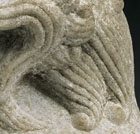J.J. Lally & Co., Oriental Art / New York City, New York
MenuPast Exhibition
Two Thousand Years of Chinese Sculpture
March 17-29, 2008
14.
A SMALL LIMESTONE FIGURE OF A LION
Tang Dynasty (618 - 907)
shown seated on its haunches with forelegs held out straight and both feet firmly planted on an integral rectangular platform base, with its head turned sharply over one shoulder and fiercely roaring with mouth open wide showing sharp teeth and pointed fangs, the large eyes with incised pupils set in an intense gaze under furrowed bushy eyebrows, the ears pinned back on either side of the thick flowing mane which extends down onto the powerfully arched back, with a short beard curling down in three points onto the muscular chest and with a long tail curled over the right hind leg, the smoothly polished stone of mottled pale silvery-white tone, with finely engraved details throughout.
Height 5 3⁄8 inches (13.7 cm)
The lion is not indigenous to China. The image of a lion was first introduced to China by ‘Silk Road’ contacts in the 4th century A.D., as the emblem of the historical Buddha Sakyamuni. Lions also appeared as guardians of the sacred law on Buddhist altarpieces and in cave temples, flanking the throne of Buddha. The supernatural power and protective strength of the lion in Buddhist iconography soon led to the use of lions as part of the retinue of animal, human and mythical guardian creatures in Chinese burial practice.
In pre-Tang China, lion sculptures were highly stylized repetitions of the imagery borrowed from Indian Buddhist art. In the Tang dynasty, however, sculptural images of the lion changed dramatically, achieving a far more realistic, animated and vigorous quality. This drastic change in artistic conception must have been the result of appearance in China of real lions for the first time.
According to literary sources, lions were brought to the Tang imperial court at Changan (modern Xi’an) as tribute gifts. The most famous instance, and possibly the first, is the arrival of a lion from Samarkand for presentation as a tribute gift to the emperor in the year A.D. 635. The emperor Taizong (r. 626-649) was so impressed by the ‘king of beasts’ that he ordered one of his highest ranking advisors, Yu Shinan, a renowned poet and calligrapher, to write a rhapsody in honor of the animal.
The animated pose and the relatively realistic, although formalized, portrayal of a lion shown here is typical of the mature Tang sculptural style in the 7th/8th century at the height of Tang dynastic power. Compare, for example, the large stone lion from the tomb of the emperor Tang Ruizong (d. 712) illustrated by Paludan in The Chinese Spirit Road, The Classical Tradition of Stone Tomb Statuary, New Haven, 1991, col. pl. 11, following p. 146.
唐 石坐獅 高 13.7 厘米
